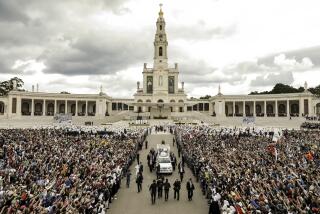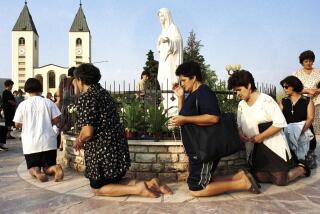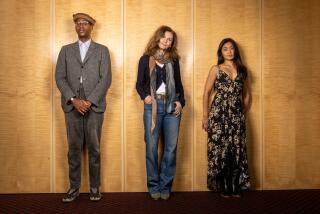Seeing and Believing : When it comes to apparitions, the Church is as skeptical as anyone. But an increase in activity is tough to ignore.
PHOENIX — Reyes Ruiz cleans his yard with a rosary clenched in his teeth, to keep both hands free for his work. But that’s not the only unusual thing that happens around his house. Five years ago, he says, his wife, Estela, told him that she saw a vision of the Virgin Mary, and the visions continue today.
On Dec. 3, 1988, the Ruizes were praying before a portrait of the Virgin that Reyes had painted. Suddenly, Estela Ruiz recalls, she saw a mist. “I thought I was going blind. The Blessed Mother appeared on a cloud. I started screaming and yelling, ‘She’s here, and she’s beautiful.’ Our Lady stole my heart.”
That took some doing. Estela Ruiz is a woman with silver hair, a quick wit and a masters degree in education. She was director of a bilingual education program for the Phoenix public schools when she started seeing visions. “I was a skeptic,” she says. “When the spiritual world enters ours, we think we must be going crazy.”
Most people would agree. They’d say that visits from angels and saints rank right up there with visions of ghosts, seances and psychic predictions as the products of a hyperactive imagination.
Traditionally, the Roman Catholic Church is as skeptical as anyone when it comes to supernatural events. “The Vatican gets 200 calls on apparitions each year. The vast majority are determined to be false” says Father Robert Faricy, a theology professor at the Gregorian Institute in Rome who has written three books on such events.
But too much has happened in recent history for the Catholic Church to overlook it all. Since 1981, when six children in the rural town of Medjugorje, Bosnia, told of meeting the Blessed Mother on a hillside, there has been a notable increase in reports of religious apparitions worldwide. About 15 million people have visited Medjugorje. Two of the six children are said to continue meeting the Virgin each evening and receiving her messages. Pilgrims report miracle healings and rosary beads that miraculously turn gold.
Dozens of similar encounters have been reported in recent years. Most reported visions are of the Virgin appearing to Roman Catholics. Many continue over several years and attract so many visitors that pilgrim sites spring up. Thousands of people have traveled to the Ruiz home during the past five years. Other pilgrim sites have flourished in Scottsdale, Ariz.; Santa Maria, Calif.; Conyers, Ga.; Cortnadreha, Ireland; Kibeho, Rwanda, and Akita, Japan.
Officially, the Vatican does not get involved in these events. But in 1978, a papal department prepared a letter updating guidelines for investigating apparitions, says Father Johann Roten, director of the Marian Research Institute for academic studies concerning the Virgin Mother, at the Catholic University of Dayton, Ohio.
It is up to the local bishop to decide when an investigation is warranted, Roten explains. The bishop forms a commission that includes theologians expert at discerning apparitions (as well as satanism), medical and psychological doctors, and the pastor of the local church.
The group looks for answers to two major questions: Do any of the messages the seers claim to receive agree with church teachings? And, how much good has come to those attracted to the site? Both spiritual conversions and physical healings qualify as good, Roten explains.
Another key question is whether the event can be explained by natural causes. Usually, the church favors that explanation. In Scottsdale, Ariz., where nine members of the St. Maria Gorretti parish believed that they heard messages from Jesus and Mary starting in the late 1980s, Bishop Thomas O’Brien’s commission decided the messages could be explained by “ordinary human dynamics,” the sort experienced during prayerful meditation.
Even sites that draw vast numbers of pilgrims over long years face official resistance. Medjugorje has been under investigation--in “discernment” to use church language--since 1985. Events at the Ruiz household are also in discernment.
Despite the extreme caution taken, a rise in official investigations signals a change in attitude, Roten says. “The church is loosening up. Concerning apparitions, it is more open than it has been.” He believes the new openness reflects changing social trends. “People today are frustrated by rationalism as the only explanation of life,” Roten says. “As a result we have a revival of religious spirit, of New Age spirituality; we have discussions about values. All this is telling us, ‘There is a different approach to life.’ ”
Outside observers tend to view reported apparitions of Mary and Jesus as part of a long tradition within Catholic Church history. (See accompanying story.) “When I hear that a Catholic saw the Virgin Mary, I don’t laugh,” says Daniel Gordis, an assistant professor of philosophy at the University of Judaism in Los Angeles. “Catholicism always went beyond what your eye could see.” Another example, he says, is the Catholic sacrament of the Eucharist. Doctrine holds that bread and wine become the real presence of Christ’s body and blood, even though there is no visible proof.
“I understand the religious passion that gives rise to those beliefs,” says Gordis of apparitions. “And people who take religious traditions seriously have to allow for the possibility that the visions do occur.” He includes himself in that group.
Catholics aren’t the only seers, notes Robert Ellwood, a professor of comparative religion at the University of Southern California. “Protestants have visions of angels, or of Jesus. Hindus have visions of Krishna. Catholics expect to see the Blessed Virgin, and so they do,” he says. “It’s part of their individual belief systems. It’s within their individual traditions.”
Faricy has an entirely different explanation for the increase in reported apparitions since Medjugorje. “The world’s in trouble,” he says. “We’ve made a mess of it.”
*
Some believers consider Medjugorje to be a spiritual comet in the modern world. They might also say a number of metaphysical meteors have burst on the scene lately, burned bright, then fizzled. Some have been just plain silly. The face of Jesus on a tortilla shell drew busloads to Lake Arthur, N.M., in 1978. A similar image in a spaghetti ad attracted crowds to a billboard in Atlanta in 1991.
The church considers some apparitions copycats. They mirror visions of the past, most notably those at Fatima, Portugal, and Lourdes, France. The church has long since accepted as authentic that in 1917 the Virgin appeared to three children in Fatima and in 1858 she appeared to a shepherd girl at Lourdes. Both times she gave the children messages, asking that the faithful pray for peace and strive for holiness.
But “after Lourdes, there were some 50 apparitions like it reported around Paris,” says Thomas Petrisko, president of the Center for Peace. Based in Pittsburgh, Pa., it is one of about 300 such nonprofit centers around the country that supply information on reported apparitions of the Virgin. Petrisko publishes a monthly newsletter and is completing a four-part series on the history of modern apparitions. Petrisko is a Catholic layman, whose Peace Center is not directly affiliated with the church.
Faricy says some reported visions turn out to be “authentic coincidences.” Two years ago, hundreds trekked to a tree in North Hollywood to see the image of Mary in the tree bark, until it was determined to be a natural formation caused by sap. One year earlier, a reported image of Mary in the tile wall of a Santa Ana church drew crowds until it faded with the natural sunlight. In Santa Ana last month, a cross reflected in a bathroom window drew hundreds of visitors to a small house. The landlord heard about it, changed the glass and the image was gone.
“There’ve been dozens of asteroid type events in Southern California lately,” Petrisko says. “But nothing the big-boy theologians are looking at closely.”
*
In September, 1988, Reyes Ruiz was on a pilgrimage in Medjugorje, praying for his then-skeptical wife. She told him that praying was for people who couldn’t get what they needed for themselves, and she refused to go with him. He was there on a vacation from his job for the Catholic Diocesean Office of Phoenix. He works with undocumented farm workers.
Estela says she was not a particularly religious person at the time, but that week she recalls having her first encounter with the Blessed Mother. She was walking past a painting of Our Lady of Guadalupe, one of many religious artworks by Reyes in their house. Other times she had passed it and thought, “Why can’t we have landscapes like everybody else?” That morning, however, she recalls hearing a voice say, “Good morning daughter.”
There was no vision to accompany the voice. Those started three months later, she says. “I thought to myself, ‘There’s no way I’m going to tell anybody about this.’ I’d lose prestige.” But afterward she felt herself opening up to spiritual life.
When her husband came home she told him what had happened and started to attend daily Mass with him. She expected him to be shocked, but he wasn’t. “When you pray for something, change doesn’t surprise you,” he says.
Looking back at her old self, Estela Ruiz now believes, “I had become worldly. I was into the power of my job, the prestige, the money. I had everything I wanted, I felt I had no need of prayer.
“With education comes analysis of God. We analyze God, we no longer believe in God. Why should we pray?”
She believes that the mystical events reported around the world today are related. For her, “Medjugorje was Our Lady’s grand entrance into the world. God sent his mother to lead us back to him. These are times of great mercy.”
Since Reyes Ruiz visited Medjugorje, life has changed for the entire family. His wife quit her job and gave up her $40,000 salary. They now live on Reyes’ $20,000 annual income. They travel the country telling their story, invited by church groups who finance their trips. They will speak at Blessed Sacrament Church in Westminster on July 21. Estela Ruiz continues to see the Blessed Mother and receives a message each month, she says. That day several hundred pilgrims come to the house. The messages are faxed to people around the world, on request.
The seven Ruiz children and 20 grandchildren pitch in on other projects. They helped Reyes Ruiz build a shrine in his back yard and they have acted in Bible skits put on for the busloads of school children who come to the house for a day, from around the Southwest. At the center of the activities is a group of 100 or so regulars who gather in the back yard twice each week to pray.
“When I met Estela, she was going for it,” recalls a family friend, Tom Esperanza. “Feminist, Chicana, masters degree. Now, their entire life is different.”
More to Read
Sign up for Essential California
The most important California stories and recommendations in your inbox every morning.
You may occasionally receive promotional content from the Los Angeles Times.










